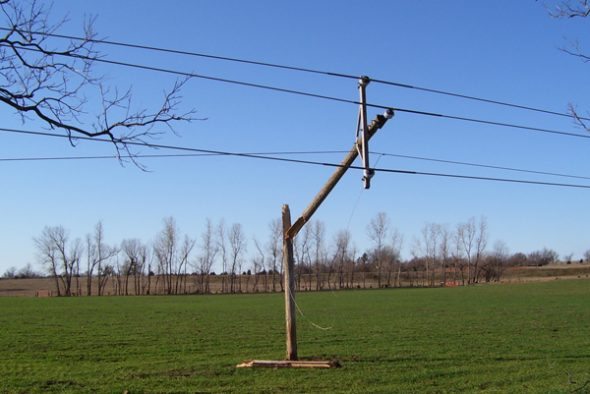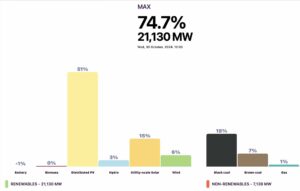Queensland fancies itself as a coal state, and the Labor government’s support of the huge mega coal projects in the Galilee Basin has attracted widespread criticism from environmental groups. But it has done a fantastic service to Australia’s clean energy debate with the release of the draft report into its planned 50 per cent renewable energy target.
The report – prepared by an independent panel drawn mostly from the banking and energy industries – smashes so many renewable energy myths it is difficult to know where to start.

But broadly speaking, it attacks the underlining assumption that renewables are expensive, unreliable, require huge subsidies and threaten the stability of the electricity system.
The Queensland report says this is simply not true: it says the state can reach what the Coalition (and many in the mainstream media) dismiss as an expensive and reckless target with little subsidy, and no impact on reliability. At the same time, renewables can reduce costs to consumers, create jobs, add new industries and add to economic growth.
Here are some of the major myths the report tackles.
Myth No 1: The costs of large scale targets.
The federal government has been running a campaign for months about the cost of the renewable energy targets in Queensland and Victoria. Last week, it put pressure on state governments to abandon their targets in the wake of the South Australia blackout, and claimed (with no evidence) that the cost of those targets would be $41 billion and that this would be carried by consumers. Of that $41 billion, $27 billion was attributed to Queensland.
But the Queensland panel found the cost of extra large-scale renewables investment would be around $6 billion, less than one quarter of that suggested by the federal government. Even if you add in the cost of rooftop solar on households and businesses, this would take the figure to no more than $10 billion. But those adding solar are reducing their bills and getting a quick payback on their investment, so it hardly counts as a burden on consumers.
It might be worth noting that one of the panellists is Paul Hyslop of ACIL Allen, whose firm was hired by utilities to fight against renewable energy targets and was the first choice of the Warburton Review into the RET.
Myth No 2: The 50% RET will require huge subsidies
Earlier this year, the Queensland Productivity Commission issued a report claiming that the target would require total subsidies of more than $10 billion. The panel’s finding? Less than $1 billion, and possibly as low as $500 million. The reason for this? The cost of technology is falling quickly, and the state will likely offer little more than a “contract for difference” – making up the difference between the wholesale price of electricity, and a long-term contract for the developer of the wind or solar farm, if it is higher.
Auctions will be used to find the lowest contract, a mechanism used with great success in the ACT and overseas, where it has driven the cost of wind energy and solar to record lows. (One irony about this subsidy is that ACIL Allen was the author of much of the QPC modelling, and for the Warburton RET review before that, and for some serious RET opponents before that).
Myth No 3: The 50% target will push up costs to consumers
This is the common scare campaign, but it was rejected outright by the panel. It estimates that prices for consumers will actually fall just over 1.2 per cent, although it is happy to describe this as “cost neutral”. The reason for this outcome is that the cost of any subsidy (quite minimal anyway) will be more than offset by an expected fall in wholesale prices. This should be no surprise, because every other investigation of renewable energy targets, including the modelling by ACIL Allen for the Warburton Review, found pretty much the same thing. But as we noted yesterday, mainstream media doesn’t want to know. “I just don’t buy it,” declared the Nine Network’s correspondent at the media briefing.
The panel also looked at the situation in South Australia, which is top of mind at the moment considering the recent price spikes and the blackout, all of which have been blamed, without merit, on the prevalence of wind energy.
South Australia Myth No 1: Renewables have increased prices in the state
As the panel notes: The average wholesale price in South Australia has consistently been higher than in other regions, independent of the growth in renewable generation over time.
That’s because of its high reliance on gas, which is an expensive source of generation. Historically, the state has relied on gas for 40-50 per cent of its supply, and while that fell when wind and solar were built it is now back up to 45 per cent following the closure of the more polluting coal plant.
 The problem now is that gas prices are even more expensive, the panel notes, and the South Australia market is dominated by a limited number of participants, who have been able to exploit the market and have been behind many of the biggest price spikes, as we have reported here, here and here.
The problem now is that gas prices are even more expensive, the panel notes, and the South Australia market is dominated by a limited number of participants, who have been able to exploit the market and have been behind many of the biggest price spikes, as we have reported here, here and here.
South Australia Myth No 2: High renewables threaten system reliability
This has been the biggest scare campaign against renewables, along with energy “security” – see below. The panel says: “AEMO has not identified any impact on system reliability as a result of the high penetration of renewable generation to date.”
It does say that AEMO has identified issues in certain circumstances and its worst case scenario, such as the closure of coal generators in Victoria, and times of high demand, low solar and wind generation and network issues.
But as we pointed out at the time, this still leaves the system within the design reliability parameters, and the state most affected by these changes will be coal-dependent NSW, not South Australia. And, as the panel notes, these issues can be address by developments in storage and demand-side management opportunities.
South Australia Myth No 3: High renewable penetrations will affect system security
The panel notes that on the issue of energy security, AEMO has “not identified any system security challenges that cannot be managed through existing processes and procedures.” Which is not to say that there are no challenges, simply that these can be dealt with.
It quotes ERM Power, one of the bigger generation companies, as saying: “The NEM is currently providing adequate investment signals that will allow markets to continue to operate efficiently under higher propositions of non-synchronous renewable energy generation. As such, no change is needed in the short term.”
Not everyone would agree with that last sentence. Some suggest that the market for FCAS, or frequency and ancillary services, should be broadened beyond the handful of providers – to providers of battery storage, or even the renewable energy generators themselves – to ensure that the market is not controlled , and exploited, by a handful of players.










